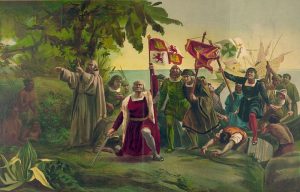Readings
In 1492, Columbus Sailed the Ocean Blue…

In his journals Columbus described the new lands in front of him “as being very flat”; he wrote that “the land was ideal for cultivation, covered with trees right down to the rivers… [He was amazed how]… these trees were lovely and green and each bore its own fruit or flower.”
Columbus commented that there were many birds, large and small, which sung sweetly, and “… there were a great number of palms of moderate height and the Indians covered their houses with them.”
Like Columbus, early chroniclers could not suppress their amazement of the whole Caribbean region which they praised for being a stand of precious wood—mahogany, cedar, ebony, in whose shade, they insisted, one could walk from one end of the island to the other.
My intention in quoting Columbus here is not to repeat this story as an unproblematic historical fact, instead I want to consider how this retelling of what Columbus and those that came after him saw reveals the importance of forests within the grand story of colonialism. The exploitation of these forests would within a few years of Columbus’ writing require the forced displacement of global populations– the removal of indigenous populations from their ancestral lands, and within less than a century, the forced transport of enslaved labor required to clear the forests to make way for agriculture.
Deconstructing commemorative narratives of the ‘discovery’ are worthwhile as doing so permits questioning just why characteristics of a land and a people, (such as the abundance of trees and the uses the Native population found for them, the flatness of the land and the variety of birds, as well as the mere ability to move about and to walk in the shade of ancient trees from one end of the island to the other), would be so important as to prompt other humans to cross the Atlantic Ocean and occupy the space.
What vast amounts of forests had already been lost in Europe that the mention of these natural resources and descriptions of a docile Native population were noteworthy to Columbus, and of even greater interest to the King of Spain?
Food for thought…
Giving attention to the environmental history of colonialism allows for different questions to be asked: For example, to what extent is the omission of Indigenous populations within environmental history normalized? And second, how was the Western Hemisphere’s environment altered by the growth of colonial agriculture, slavery and by the massive forced migration across the Atlantic of African populations?
Other questions that arise include:
- What did land mean for those doing the ‘discovering’?
- Why would the mere act of walking freely, underneath a canopy of trees. seem so special to merit it being listed as significant?
- Was the environment of settlers, by comparison, devoid of natural resources and constrained– thereby impeding ‘walking freely.’
- And, who or whom is it that would be granted the right to ‘walk freely’?
- Do we today walk freely through forests? Or, through our neighborhoods?
- What is it that remains of the vast forests Columbus described?
Ultimately an attention to the land, the trees and the ability to walk allows us to consider the quality of the environment for those living without the trees 500 years after Columbus’ voyage.
A Walk Through Nature
Immerse yourself in the conserved, natural surroundings of UCF’s Aboretum through the following technologies:
- The web version – This website requires an internet connection.
- The augmented reality (AR) version – This AR experience requires iOS 11 or Android 7.0 or later.
- The virtual reality (VR) version – This VR experience requires Windows 10 (with a GeForce® GTX 1070 with 8GB GDDR5 and other requires—see website for more info).
*Learn more about the legacy of colonialism through this module’s Extra Credit Assignment “A Walk through Nature.”

